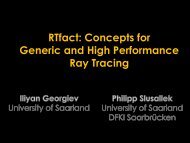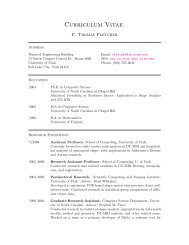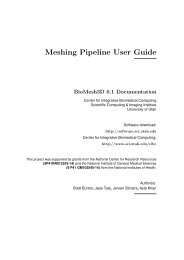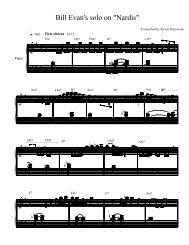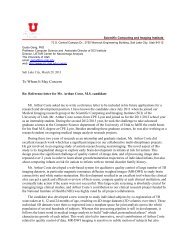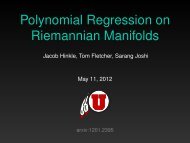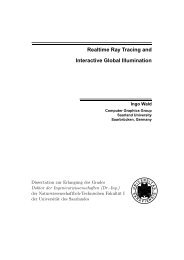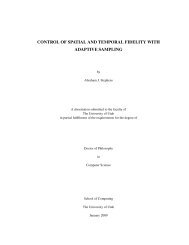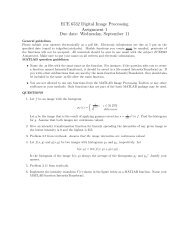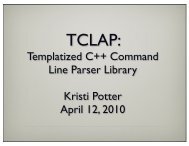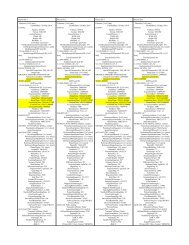SCIRun Forward/Inverse ECG Toolkit - Scientific Computing and ...
SCIRun Forward/Inverse ECG Toolkit - Scientific Computing and ...
SCIRun Forward/Inverse ECG Toolkit - Scientific Computing and ...
Create successful ePaper yourself
Turn your PDF publications into a flip-book with our unique Google optimized e-Paper software.
where λ is the regularization parameter, which is a user defined scalar value. The matrix P<br />
represents the a priori knowledge of the measurements. The matrix L describes the property<br />
of the solution x to be constrained. Conceptually, λ trades off between the misfit between<br />
predicted <strong>and</strong> measured data (the first term in the equation) <strong>and</strong> the a priori constraint.<br />
An approximate solution ˆx of 2.9 is given for the overdetermined case (n > m) as follows:<br />
‖P −1 (y − Ax)‖ 2 2 + λ 2 ‖Lx‖ 2 2 = f(x)<br />
(A T P T P A + λ 2 (L T L) −1 )ˆx = A T P T P y (2.10)<br />
(2.11)<br />
<strong>and</strong> for the underdetermined case (n < m) as:<br />
‖C −1 (y − Ax)‖ 2 2 + λ 2 ‖W x‖ 2 2 = f(x)<br />
W W T A T (AW W T A T + λ 2 (CC T ) −1 ) −1 y = ˆx (2.12)<br />
(2.13)<br />
with source space weighting W, L ∈ n × n <strong>and</strong> sensor space weighting C, P ∈ m × m.<br />
When n = m, either of the above formulations can be used. Both solutions are equal<br />
but the computational effort may differ. Furthermore, both representations can be solved<br />
numerically by a direct method (e.g. Gaussian elimination) or an iterative method (e.g.<br />
conjugate gradients). Both methods are implemented in <strong>SCIRun</strong>.<br />
An alternative approach to solve the Tikhonov minimization involves a singular value<br />
decomposition (SVD) of the matrix A. The SVD results in several factor matrices, from<br />
which one then obtains the inverse solution. The SVD approach is also implemented in<br />
<strong>SCIRun</strong> <strong>and</strong> will be described below.<br />
Choosing the regularization parameter:<br />
Choosing an appropriate value as a regularization parameter is critical for achieving useful<br />
solutions. The solution typically depends on it in a sensitive fashion, <strong>and</strong> good choices vary<br />
with the size, smoothness, etc. of the problem/solution as well as on the choice of regularization<br />
constraint. One commonly-used method to choose the regularization parameter<br />
automatically is to run the inverse solution for a large variety of parameters. For all regularization<br />
parameters, the residual norm (fit of the data, ‖y − Aˆx‖ 2 2 ) <strong>and</strong> the weighted solution<br />
norm (solution properties, ‖Lˆx‖ 2 2 ) is plotted in a log-log plot. Often, the resulting curve<br />
shape looks similar to the letter ”L”. The corner of the ”L” represents a good trade off<br />
between both constraints. The automatic parameter selection used in this L-curve approach<br />
can be used for underdetermined <strong>and</strong> the overdetermined case as in option in the module<br />
Solve<strong>Inverse</strong>ProblemWithTikhonov.<br />
Truncated SVD Tikhonov regularization<br />
Another approach to regularization is to approximate A with a low-rank substitute by<br />
truncating the low-order modes of its SVD. The choice of rank is equivalent to the choice<br />
of regularization parameter.<br />
12 Chapter 2



